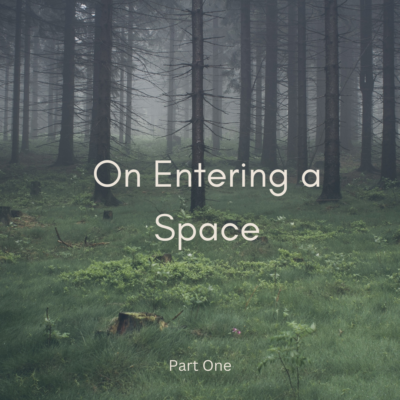We all enter spaces: Walk through doorways. Jump in a pool, or the ocean. Step into a meadow. Open a fence gate and enter a garden. Daily, annually, every moment, we enter (and leave and enter, again) a space.
When I teach eco-somatic movement, I invite movers to consider that every time we step onto a natural surface (earth, mud, stone, sand) there are tiny microorganisms under our feet. How many survive? How often do we consider the literal weight of our step onto any earthly surface? Entering, do we consider our impact beyond our time there?
This awareness and practice lives at a cross section of my life. Equally spiritual and practical, an experience during one of my humanitarian assignments illustrates the practical importance of this. In 2005, I was part of a research team interviewing survivors of torture in Mexico. We visited one community so close to the US border we could see a Jack in the Box just across a river. When we arrived, the small town appeared to be “closed”. All the curtains were shut, and no-one was out. After we stood in the town square, a few faces peered out from behind the curtains. Finally, one door opened a little, and I introduced ourselves (they were aware we would be arriving). A few of the households agreed to speak with us. They were open to sharing their stories.
The stories’ details are too many and too explicit for this newsletter. We learned that all the men in the village were either dead or imprisoned. Those imprisoned were being tortured. We learned that this community was under surveillance by the cartel and the military. They agreed to speak with us again, because we were connected to human rights organizations who had agreed to support the communities we visited. We returned two days later, and the whole town was quiet and eerily still. Finally, a door opened and a woman waved me over.
“They were here after you left. They threatened us. We cannot talk to you. You need to leave now.”
I was followed by the cartel several times during my remaining time there. And when I left, and many times since, I contemplated the consequences of our visit for that community. Our visit there was one of many to various towns and prisons; we were guided by governments, and had support from human rights organizations. We agreed we never ever would have gone there if we had known the potential danger to this community. We left. They stayed. What happened to them after our visit?
That question is a pillar of my teaching to humanitarian workers headed out on assignment: As you prepare to enter this space, begin considering how you will leave it when you get to go home because this scenario repeats any time we deploy to a disaster or complex humanitarian emergency, and have the privilege of returning home. It’s amplified when we are evacuated from dangerous contexts and leave our host country colleagues behind. I will never forget evacuating from Haiti in 2004 when violence was erupting everywhere. I was ushered out easily; lines of Haitians waited at the airport, praying to leave*. The depth of inequity that permeates international development and humanitarian work, as I wrote last month, is an ongoing consequence of colonialism. There is so much more to say here. I will resume this thread in a future newsletter.
Many of my Indigenous teachers remind me to enter spaces in the natural world consciously. Whether going for an ocean swim, taking a nap in a forest or resting on a log, I have been taught to pause, connect with the space I am about to enter and therefore change, and ask permission because my presence there will have an impact. This is also a process of discernment, and that, along with white whales, hermit crabs and seashells will be next month’s topic
